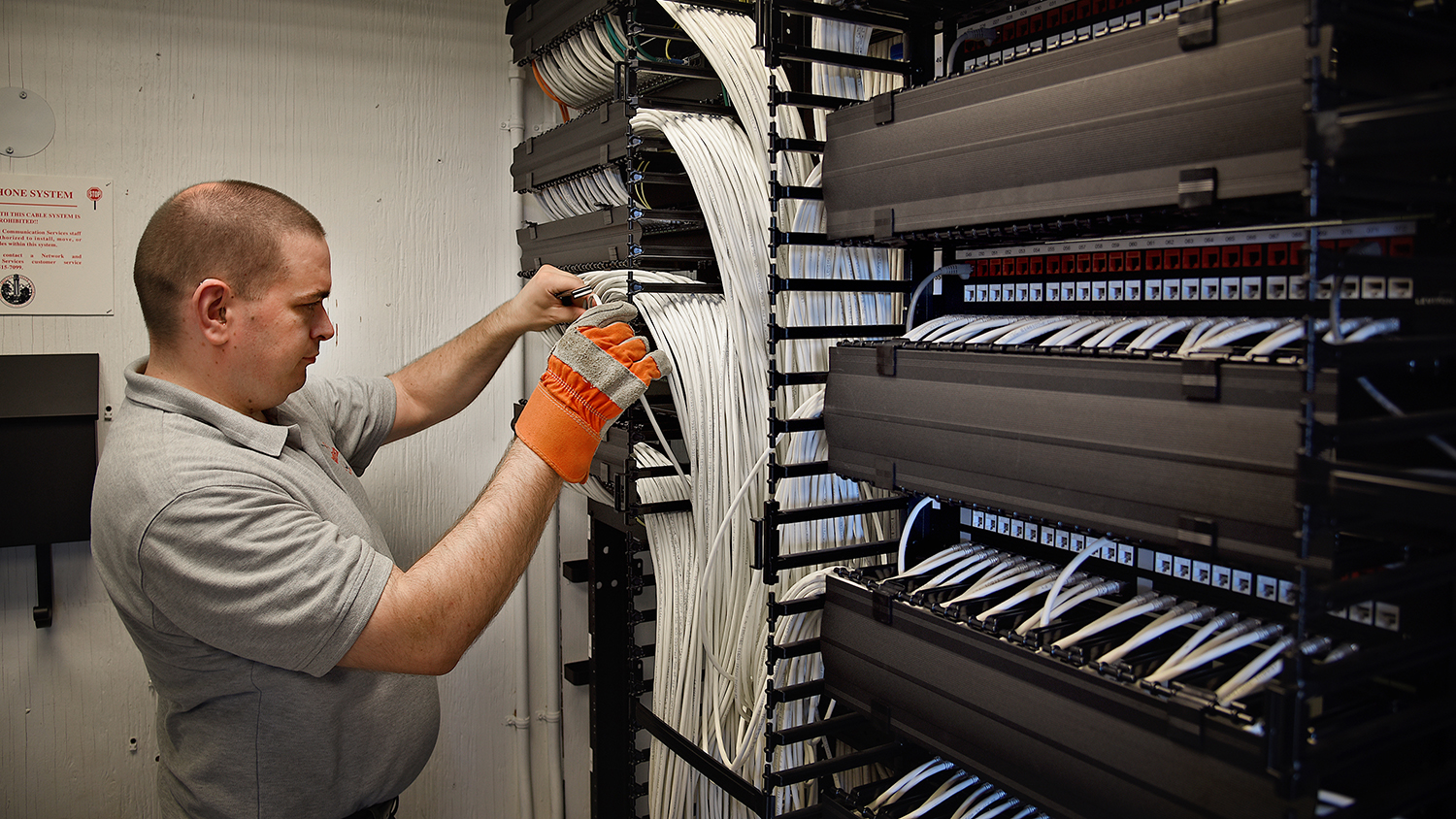Residence Halls Gain Faster Online Network

It’s easier than ever for students to do research online, email their professors and stream Game of Thrones in their rooms.
The Office of Information Technology recently completed a major upgrade to the network infrastructure in residence halls and apartment buildings on campus. Now students enjoy faster, smoother internet, both wired and wireless, on multiple devices.
“Our students want/need more and more bandwidth to do all the things they want to do, whether that’s education-related, entertainment-related, watching Netflix or whatever it is they might use it for,” says Ed Rogers, who leads the engineering and construction division of Communication Technologies within OIT.
The result is a network that replaces an obsolete system with up-to-date technology and leaves room for future improvement. It also puts NC State at the forefront of universities when it comes to internet in residence halls.
“It would be physically impossible for someone to have better,” Rogers says.
Back in the Day
Residence halls got their first network infrastructure in the 1990s. That system used category 5 cabling, capable of a maximum speed of 100 megabits per second — not enough for thousands of people who want to stream music, connect with friends and watch videos all online. In the early 2000s, OIT began upgrading some buildings to category 6 cabling, capable of 1 gigabit per second. In 2012, a large project kicked off to upgrade the remaining so-called “Cat 5” buildings to category 6A cabling — the best on the market, Rogers says, capable of 10 gigabits per second, much faster than typical internet speeds today.

The category 5 cabling was obsolete, but the physical conduits through which the cables ran were still usable.
“We were able to reuse that pathway system that was already there and just pull old cables out and put new cables in,” Rogers says. “And so it was less expensive than having to drill holes and do all that kind of stuff that we did back in the ‘90s.”
Altogether, OIT replaced 900 miles of cable — enough to stretch from Raleigh to Milwaukee, Wisconsin — in short bursts over multiple summers when student housing was empty.
OIT also replaced hundreds of network switches, components that manage devices plugged into a network, upgrading those from 100 megabits per second to 1 gigabit per second. Even though the cabling is capable of 10 times that speed, switches of the same caliber are just emerging and are very expensive, Rogers says. Network switches typically are replaced every five to eight years, leaving the option open for future upgrades.
The new cable and network switches mean the internet is faster than ever when students plug in — and the same applies when they are on the move.
Better Wireless
Rogers recognizes the importance of wireless to students today.
“That’s the primary way students want to connect everything, from their phone to their tablet to gaming systems and all that,” he says. “As wireless demands keep going up, more and more devices need more and more bandwidth, particularly for things using video, like Netflix.”
Until now, students usually brought their own wireless routers to residence halls. The problem, Rogers says, is these routers operated on a limited number of channels, causing them to interfere with one another.
“If you have a crowded residence hall, it’s like a whole bunch of radios trying to broadcast in the same space,” he says. “It doesn’t work so great.”
Last summer, OIT installed a wireless access point in every student’s room and each apartment in Wolf Village and Wolf Ridge — 4,367 devices in all — with speed of 300 megabits per second. Each device also comes with three wired ports so students can plug in game consoles or TVs for higher bandwidth. The access points, small white boxes affixed to the wall, use the same new cabling as the wired system and, like the other network components, are the most advanced on the market.
The access points communicate with a single controller, or “brain,” as Rogers put it, to reduce interference and maximize speed. The new system also means students can move around residence halls and remain on the network. Previously, students had to reconnect to the network if they left their rooms.
Rogers says wireless internet has moved from a luxury to a staple and that’s why it’s important to have a fast, reliable system in place.
“Wireless to most students coming in today is just normal for them,” he says. “They expect Wi-Fi to be everywhere and you shouldn’t have to ask if it’s there. It’s just expected.”
The Right Equipment at the Right Time
Upgrading the cables, network switches and wireless took about six years. OIT worked around the academic schedule and the release of new technology — such as waiting a year to get the newest generation of access points that are three times faster than previous ones.
“We feel like we’ve jumped at the right time to get the highest technology available in a cost-effective manner,” Rogers says.
The upgrades cost $6.8 million, excluding work done before 2012, and came in under budget by 1.4 percent. Funds came from an increase in student resident fees, from $115 to $140 per student per semester. OIT discussed the increase with students on the Inter-Residence Council, the governing body for NC State’s residential community, before work started.
Rogers won’t say NC State is unique when it comes to its residence hall network, but he says the university is at the forefront. Few universities are putting an access point in each room, and no university can top the upgraded network, which takes advantage of NC State’s high-speed, high-capacity fiber optic data infrastructure.
“There’s really nothing on the market better than what we put in,” Rogers says. “I can guarantee no one’s got more.”
The upgrade serves a dual purpose: satisfying current students and luring new ones.
“We know that NC State is competing for students, and top students particularly,” Rogers says. “Quality of life in the residence halls is part of that, and part of that part of life is network connectivity.”
Rogers says the upgrade seems to have gone smoothly. Little has changed on the front end and his department hasn’t heard of many problems — and it likely would if things were going wrong.
“I think you could probably cut off the water, the lights and the air conditioning and you’d probably have less complaints than if students lost internet,” he says.
- Categories:


